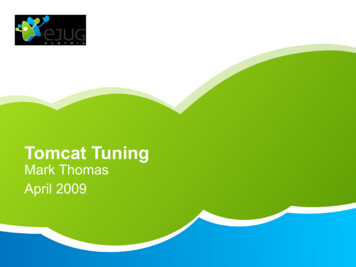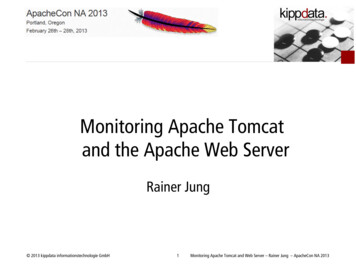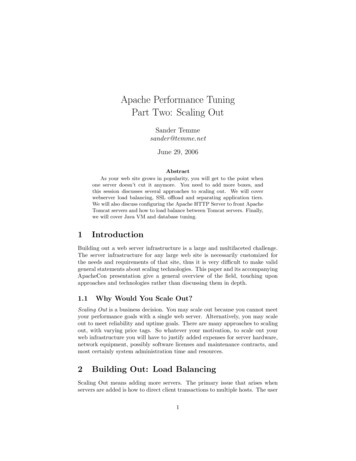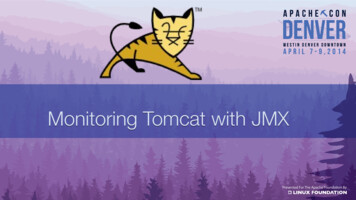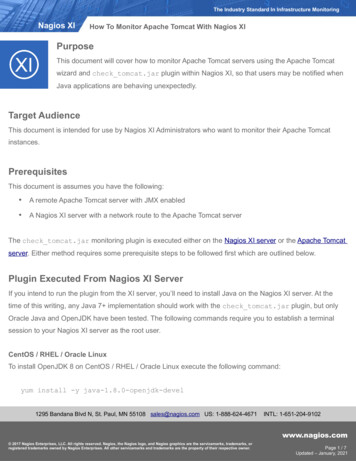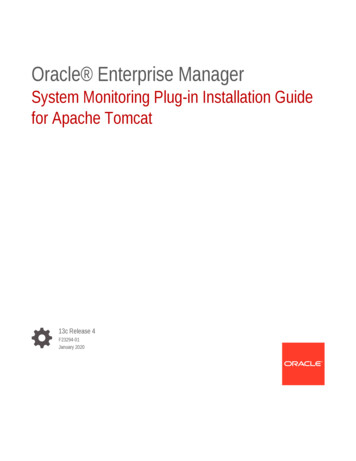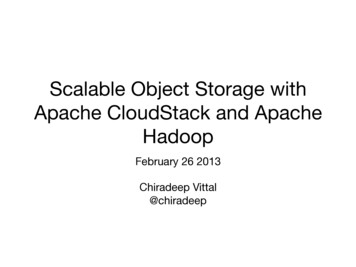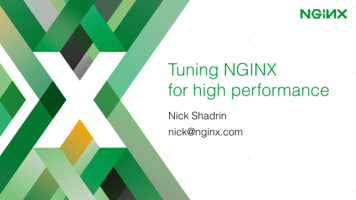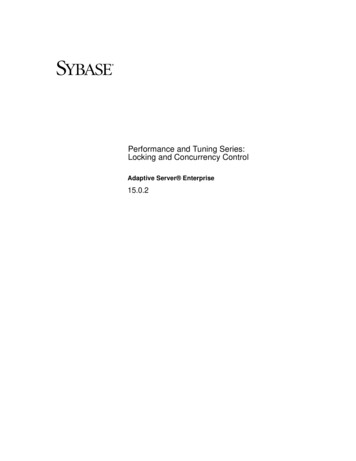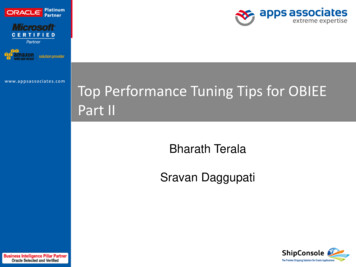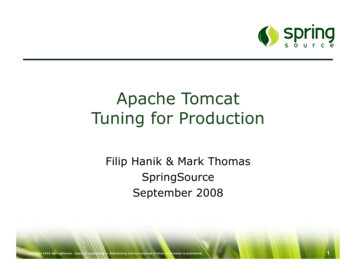
Transcription
Apache TomcatTuning for ProductionFilip Hanik & Mark ThomasSpringSourceSeptember 2008Copyright 2008 SpringSource. Copying, publishing or distributing without express written permission is prohibited.1
About SpringSource Created, developed and leads SpringRod Johnson, CEO and father of SpringDeep Apache involvementProvide full commercial support forApache Tomcat Offer a host of production ready Apacheand Spring-based products Offices worldwide – US, UK, France,Netherlands, Germany, Australia andCanadaCopyright 2008 SpringSource. Copying, publishing or distributing without express written permission is prohibited.2
About the presenters Apache Tomcat Committers for 5 years Apache Software Foundation members SpringSource technologists- Apache development team- Senior Software Engineers andConsultants Performance, troubleshooting andsecurity expertsCopyright 2008 SpringSource. Copying, publishing or distributing without express written permission is prohibited.3
Tomcat versions Focused on Tomcat 6.0.x5.5.x – bugs and security4.1.x – occasional bugs and security3.x, 4.0.x, 5.0.x are unsupported7.x is on the horizon with some initialdiscussions on the mailing listCopyright 2008 SpringSource. Copying, publishing or distributing without express written permission is prohibited.4
Agenda Review of part 1LoggingThe role of TCP and HTTP in performanceLoad balancingTuning connectors for your network– Timeouts are critical Content delivery & caching Tuning the JVM Q&ACopyright 2008 SpringSource. Copying, publishing or distributing without express written permission is prohibited.5
Review of Part 1: The process Understand the system architectureStabilise the systemSet performance targetMeasure current performanceIdentify the current bottleneckFix the root cause of the bottleneckRepeat until you meet the targetCopyright 2008 SpringSource. Copying, publishing or distributing without express written permission is prohibited.6
Review of Part 1: Availability Clustering Multiple Tomcat instances Load balancer– httpd, IIS, hardware, etc. How stateful is your applciation? How seamless do you want fail over tobe?Copyright 2008 SpringSource. Copying, publishing or distributing without express written permission is prohibited.7
Review of Part 1: Reliability Redeployment can cause memory leaks– Include redeployment in your testing Design for scalability– Include clustering in your testing In highly concurrent environments turnoff KeepAliveCopyright 2008 SpringSource. Copying, publishing or distributing without express written permission is prohibited.8
Apache Tomcat in Production Applications usually account for 80% ofrequest processing time Recall the tuning process Focus your efforts on the bottlenecks Don't try and guess the bottleneckCopyright 2008 SpringSource. Copying, publishing or distributing without express written permission is prohibited.9
Apache Tomcat in Production Out Of The Box Tomcat– Tomcat ready for production No JVM settings applied Tuning is fairly limited– So lets get to itCopyright 2008 SpringSource. Copying, publishing or distributing without express written permission is prohibited.10
Apache Tomcat in Production What will we tune?– Adjust logging– Tune connectors– Tune content cache– JVM settingsCopyright 2008 SpringSource. Copying, publishing or distributing without express written permission is prohibited.11
Production Logging Tomcat’s logging is OK But one must understand what it does– Catch-all logger goes to stdout and file– No overflow protection– Synchronized loggingCopyright 2008 SpringSource. Copying, publishing or distributing without express written permission is prohibited.12
Production Logging Remove duplicate logging(logging.properties)– Default logs to stdout and file.handlers gging.ConsoleHandler– Remove logging to stdout – no rotation.handlers 1catalina.org.apache.juli.FileHandlerCopyright 2008 SpringSource. Copying, publishing or distributing without express written permission is prohibited.13
Production Logging Overflow protection(logging.properties)– Use if your logs have the risk of overflowinghandlers 1catalina.org.apache.juli.FileHandler, – The logger name contains class file– Swap in custom implementation (or JDK)handlers 1catalina.java.util.logging.FileHandler, – Tomcat accepts a custom class nameCopyright 2008 SpringSource. Copying, publishing or distributing without express written permission is prohibited.14
Production Logging Overflow protection(logging.properties)– Size based rotation using JVM loggerhandlers 1catalina.java.util.logging.FileHandler, – No more than 5x20mb rn .util.logging.FileHandler.limit unt 5Copyright 2008 SpringSource. Copying, publishing or distributing without express written permission is prohibited.15
Production Logging Synchronous logging(logging.properties)– Can become a bottleneck– We don’t want disk IO to become the limitingfactorhandlers 1catalina.my.custom.AsyncFileHandler, – Asynchronous file handlers must be able to Limit log queue in size Fall back to sync logging or Throw away overflow log recordsto avoid out of memory errorCopyright 2008 SpringSource. Copying, publishing or distributing without express written permission is prohibited.16
Apache Tomcat in Production Tuning Tomcat connectors– server.xml– Connector To properly tune one must– Understand the TCP protocol– Understand how the CPU works– Understand load balancers and theiralgorithmsCopyright 2008 SpringSource. Copying, publishing or distributing without express written permission is prohibited.17
TCP Layer 4 in the OSI stackSession basedTCP stack implementation keeps stateFlow controlDelivery guaranteeCopyright 2008 SpringSource. Copying, publishing or distributing without express written permission is prohibited.18
TCP: Session based Setup and break down handshakes Client response time– Handshakes add to HTTP transaction time– HTTP keep alive improves client responsetime– HTTP keep alive takes up server resourcesCopyright 2008 SpringSource. Copying, publishing or distributing without express written permission is prohibited.19
TCP: Stateful protocol Each connection represented by– source address– source port– destination address– destination port This is all the information a layer 4 loadbalancer has for load balancingCopyright 2008 SpringSource. Copying, publishing or distributing without express written permission is prohibited.20
TCP: Flow control Prevents buffer overflow and lost data Server must adjust write speed to client’sability to read Servlet specification is blocking IO– Utilize a thread for the entire HTTPtransaction– For static content, Tomcat offers SEND FILEwith APR and NIO connectorsCopyright 2008 SpringSource. Copying, publishing or distributing without express written permission is prohibited.21
TCP: No Keep-AliveUser AgentServerTCP Setup (syn)TCP Setup (syn/ack)TCP Setup (ack)singleHTTPtransactionHTTP requestHTTP responseservletthreadin useTCP Close (fin)TCP Close (fin,ack)TCP Close(ack)Copyright 2008 SpringSource. Copying, publishing or distributing without express written permission is prohibited.Close can bedone in differentways22
TCP: Keep-AliveUser AgentServerTCP Setup (syn)TCP Setup (syn/ack)TCP Setup (ack)multipleHTTPtransactionsHTTP requestHTTP responseservletthreadin useTCP Abort(ack)TCP Abort (rst)Copyright 2008 SpringSource. Copying, publishing or distributing without express written permission is prohibited.23
TCP: Summary How does TCP affect our system?– Traffic patterns High concurrency/short requestsLow concurrency/long requestsStatic contentDynamic contentCombinationVariations– It’s these patterns that decide how to tuneour systemCopyright 2008 SpringSource. Copying, publishing or distributing without express written permission is prohibited.24
HTTP Layer 7 in the OSI stackStateless protocolNot tied to TCPCan be leveraged by load balancersCopyright 2008 SpringSource. Copying, publishing or distributing without express written permission is prohibited.25
HTTPS HTTP over SSL Expensive handshake– Keep alive makes a big difference Encryption hides HTTP from routingdevices For any appliances, such as LB, thismeans– Fallback to layer 4Copyright 2008 SpringSource. Copying, publishing or distributing without express written permission is prohibited.26
Load Balancing: TCP/HTTP TCP– Based on destination address/port– Connection centric – 1:1– Can lead to uneven loads HTTP– Based on HTTP headers– Can reuse server connections– Can drain sessionsCopyright 2008 SpringSource. Copying, publishing or distributing without express written permission is prohibited.27
Load Balancing: Algorithms Load balancing– Connection limits– Reusing connections– Traffic shaping Load balancing algorithm drive Tomcatconfiguration choicesCopyright 2008 SpringSource. Copying, publishing or distributing without express written permission is prohibited.28
Apache Tomcat: HTTP/S Our tuning options– Threads– Keep alive requests– TCP Backlog (acceptCount)– connectionTimeout Different connectors– BIO – Blocking Java connector, default– APR – Uses native C code for IO– NIO – Non blocking Java connectorsCopyright 2008 SpringSource. Copying, publishing or distributing without express written permission is prohibited.29
Apache Tomcat: HTTP/S Disclaimer– Tuning options are meant for working andhigh performing applications– Options will not fix bad application behavior– If application is not tuned Effects of tuning will not be visible Situation can worsenCopyright 2008 SpringSource. Copying, publishing or distributing without express written permission is prohibited.30
Which connector? Use BIO if:– Stability is the highest priority APR and NIO are more recent– Most content is dynamic– Keep alive is not a determining factorprotocol ight 2008 SpringSource. Copying, publishing or distributing without express written permission is prohibited.31
Which connector? Use APR if:– SSL is terminated at Tomcat– Platforms are Linux or Windows– Keep alive is important– Lots of static content– Using Comet featureprotocol pyright 2008 SpringSource. Copying, publishing or distributing without express written permission is prohibited.32
Which connector? Use NIO if:– Compiling APR is not an option– SSL is terminated at Tomcat– Keep alive is important– Lots of static content– Using Comet featuresprotocol pyright 2008 SpringSource. Copying, publishing or distributing without express written permission is prohibited.33
Which connector? If uncertain:– Use BIO connector– Most mature code, both in Tomcat and JVM– Will not break down– Auto tune feature to disable keep alive When hitting 75% if maxThreads in connectioncountprotocol col “HTTP/1.1” !--same as above-- Copyright 2008 SpringSource. Copying, publishing or distributing without express written permission is prohibited.34
Which connector? What about AJP?:– We don’t recommend it– Doesn’t perform better than HTTP– You lose a lot of troubleshooting andconfiguration abilities using itprotocol “AJP/1.3”Copyright 2008 SpringSource. Copying, publishing or distributing without express written permission is prohibited.35
Tuning threads maxThreads– Typical range 200-800– Maximum nr of concurrent requests– For BIO, max nr of open/active connections– Good starting value 400Copyright 2008 SpringSource. Copying, publishing or distributing without express written permission is prohibited.36
Tuning threads maxThreads “400”– Decrease if you see heavy CPU usage Application might be CPU bound instead of IObound Find out what is causing CPU usage– Increase if you don’t see much CPU usage Applications could be synchronized - no gain Take into account other resources, such as databaseconnectionsCopyright 2008 SpringSource. Copying, publishing or distributing without express written permission is prohibited.37
Tuning keep alive maxKeepAliveRequests– Typical values 1, 100-200– Represents the number of requests Tomcatwill handle on a TCP connection– Set to 1 disables keep alive– connectionTimeout/keepAliveTimeout controlsthe timeout in between requestsCopyright 2008 SpringSource. Copying, publishing or distributing without express written permission is prohibited.38
Tuning keep alive maxKeepAliveRequests– Set to 1 if Very high concurrencyNot using SSL in TomcatUsing layer 4 load balancerUsing BIO connector– Set to 1 if Using SSL or low concurrency Layer 7 load balancer with advanced features Using APR or NIO connector– BIO connector automatically disables keepalive for high connection countsCopyright 2008 SpringSource. Copying, publishing or distributing without express written permission is prohibited.39
Tuning TCP backlog acceptCount– Typical ranges 50-300– Represents nr of additional connections theOS should accept on your behalf– Useful when Tomcat can’t accept connectionsfast enoughCopyright 2008 SpringSource. Copying, publishing or distributing without express written permission is prohibited.40
Tuning TCP backlog acceptCount “100”– Increase if Very high concurrency (nr of connections) Connections getting rejected during peak traffic Keep alive should be off– Decrease if Keep alive is on Connections getting accepted but never servicedCopyright 2008 SpringSource. Copying, publishing or distributing without express written permission is prohibited.41
Tuning timeouts connectionTimeout– Values from 2000-60000– Represents the SO TIMEOUT value– Essentially, max time between TCP packetsduring a blocking read or write– Critical to a stable system– Also used for keep alive timeoutCopyright 2008 SpringSource. Copying, publishing or distributing without express written permission is prohibited.42
Tuning timeouts connectionTimeout “3000”– Increase if Working with slow clients (dial up) Using a layer 7 load balancer with connectionlimit/pool and keep alive on– Decrease if Need faster timeouts– Default value of 20,000 (20secs) is too highfor a web serverCopyright 2008 SpringSource. Copying, publishing or distributing without express written permission is prohibited.43
Content Delivery Dynamic content– No caching done– Tomcat has to deliver it blocking mode– Worker thread is not released until all contenthas been delivered– Changing connector wont change behaviorCopyright 2008 SpringSource. Copying, publishing or distributing without express written permission is prohibited.44
Content Delivery Static content– Size based cache, default 10mb– BIO - Tomcat has to deliver it blocking mode– NIO/APR Tomcat can use SEND FILE Release worker thread, deliver the content using abackground thread when the client is ready toreceive Increases concurrencyCopyright 2008 SpringSource. Copying, publishing or distributing without express written permission is prohibited.45
Content Delivery Configured in Context element 40MB cache (default 10MB) cache revalidation every 60 seconds (default 5seconds) caching enabled (default true) ContextcacheMaxSize ”40960”cacheTTL ”60000”cachingAllowed ”true” /Context Copyright 2008 SpringSource. Copying, publishing or distributing without express written permission is prohibited.46
JVM Tuning Key parameters for JVM tuning– Memory– Garbage collection They are not independentCopyright 2008 SpringSource. Copying, publishing or distributing without express written permission is prohibited.47
JVM Tuning: The ideal Short lived objects never reach the OldGeneration Short lived objects cleaned up by shortminor garbage collections Long lived objects promoted to OldGeneration Long lived objects cleaned up by (rare)full garbage collectionCopyright 2008 SpringSource. Copying, publishing or distributing without express written permission is prohibited.48
JVM Tuning: Memory -Xms/-Xmx– Used to define size of Java heap– Aim to set as low as possible– Setting too high can cause wasted memoryand long GC cycles -XX:NewSize/-XX:NewRatio– Set to 25-33% of total Java heap– Setting too high or too low leads to inefficientGCCopyright 2008 SpringSource. Copying, publishing or distributing without express written permission is prohibited.49
JVM Tuning: GC GC pauses the application– Regardless of GC algorithm Pause can range from milliseconds toseconds The pause will impact your response time– How much does this matter?Copyright 2008 SpringSource. Copying, publishing or distributing without express written permission is prohibited.50
JVM Tuning: GC -XX:MaxGCPauseMillis– Set GC pause time goal– More frequent GC– Shorter pauses– Goal is for major collections -XX:MaxGCMinorPauseMillis– Applies to young generationCopyright 2008 SpringSource. Copying, publishing or distributing without express written permission is prohibited.51
JVM Tuning: Try it out GC Settings – JDK 1.5 and 1.6-XX: UseConcMarkSweepGC-XX: CMSIncrementalMode-XX: CMSIncrementalPacing-XX:CMSIncrementalDutyCycleMin 0-XX:CMSIncrementalDutyCycle 10-XX: UseParNewGC-XX: CMSPermGenSweepingEnabled-XX:MaxGCPauseMillis 250-XX:MaxGCMinorPauseMillis 100Copyright 2008 SpringSource. Copying, publishing or distributing without express written permission is prohibited.52
JVM Tuning Much bigger topic Watch for future webinar Same tuning rules apply– Doesn’t compensate for bad, slow or poorlywritten applications Sun JDK ons-list.htmlCopyright 2008 SpringSource. Copying, publishing or distributing without express written permission is prohibited.53
SpringSource Products andServices SpringSource Support SpringSource ERS– Commercial distribution of Apache Tomcat,HTTPd SpringSource Application Platform– SpringSource Enterprise– SpringSource dm ServerCopyright 2008 SpringSource. Copying, publishing or distributing without express written permission is prohibited.54
Apache Tomcat Support Enterprise level commercial support– Guaranteed SLA’s– Guaranteed bug fixes– Security notifications and patches Consulting– Troubleshooting– Training– Security, performance and best practicesreviewsCopyright 2008 SpringSource. Copying, publishing or distributing without express written permission is prohibited.55
Enterprise Support onPlatinum PlanLevel 11 Hour72 HoursNext ReleaseTimes: 24 x 7 x 365Method: phone or webLevel 24 Hours5 Business DaysNext ReleaseLevel 31 Business DayNext ReleaseNext onLevel 14 Hours72 HoursNext ReleaseLevel 21 Business Day5 Business DaysNext ReleaseLevel 32 Business DaysNext ReleaseNext onLevel 11 Business DayNoneNext ReleaseLevel 22 Business DaysNoneNext ReleaseLevel 34 Business DaysNoneNext ReleaseGold PlanTimes: 6AM – 6PM local time, weekdays,excluding national holidaysMethod: phone or webSilver PlanTimes: 6AM – 6PM local time, weekdays,excluding national holidaysMethod: webCopyright 2008 SpringSource. Copying, publishing or distributing without express written permission is prohibited.56
SpringOne Americas 2008Americas 2008 World’s Biggest Conference on Spring & TomcatKeynotes by Rod Johnson, Adrian ColyerOver 70 sessions in 5 technical tracksTechnical Sessions, Case Studies, Best PracticesExtensive sessions on production configurationof Tomcat in large scale enterprise systems Register now for special discountsDec 1-4, 2008Hollywood, FLww
Tuning keep alive maxKeepAliveRequests –Set to 1 if Very high concurrency Not using SSL in Tomcat Using layer 4 load balancer Using BIO connector –Set to 1 if Using SSL or low concurrency Layer 7 load balancer with advanced features Using APR or
